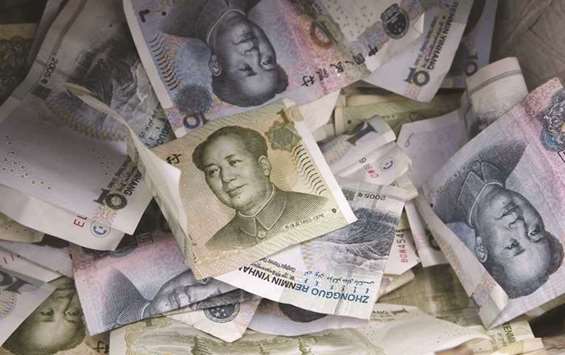China’s yuan fell to a 14-month low against the dollar yesterday in domestic trading, pulled down by worries over an escalation in Sino-US trade tensions.
The central bank raised the yuan’s midpoint for the start of trading for the first time in five sessions, but the yuan weakened as the market absorbed news that US President Donald Trump was looking to ratchet up pressure on Beijing in their trade dispute.
Trump wants to raise the tariff on $200bn of Chinese goods to 25% from a previously proposed 10%. The news also rattled China’s stocks markets.
“Besides the prospect of a protracted US-China trade conflict, we would note that CNY valuations are not compelling even after the recent sell-off... China’s share of global goods exports has trended lower,” said Jonathan Cavenagh, head of currency strategy for emerging Asia at JPMorgan Chase in Singapore.
Despite some concerns in markets the dispute between the world’s two largest economies could turn into a currency war, Neeraj Seth, head of Asian Credit at BlackRock, said such risks were “low”.
“CNY is a tool for them (China) to fight US tariffs, but not the first one that they use in a big way as it does hurt stability on capital account front. I don’t think we see any significant depreciation of CNY on cards here,” Seth told the Reuters Global Markets Forum yesterday.
Prior to the market opening yesterday, the People’s Bank of China increased the midpoint rate for the first time in five sessions to 6.7942 per dollar, up 0.5% from the previous fix of 6.8293.
In the spot market, the onshore yuan opened at 6.8080 per dollar and finished domestic trading at 6.8300, the weakest close since June last year.
Traders said they expected the yuan to trade in a range of 6.8 to 6.85 per dollar in the near-term.
Deutsche Bank economists said in a note that the trade tensions would apply “persistent” pressure on China’s current account in the next few years.
It forecast the currency would fall to 6.95 per dollar by the end of the year, compared with its previous expectations of 6.8. It sees the currency ending 2019 at 7.4 per dollar.
Rising US interest rates are also putting the yuan and other emerging market currencies under pressure.
The US Federal Reserve on Wednesday kept its interest rates unchanged, as widely expected.
But in characterising the economy as strong, it underpinned expectations it would raise rates in September and December.
The global dollar index, a gauge of the unit’s strength against six other major currencies, had risen to 94.909 as of 0830 GMT, compared with the previous close of 94.624.
Market participants have speculated Chinese authorities may allow the yuan to weaken more over the rest of the year as the government has so far been uncharacteristically hands-off in its approach to the rapidly declining currency.
The offshore yuan was trading at 6.8416 as of 0830 GMT.

In the spot market, the onshore yuan opened at 6.8080 per dollar and finished domestic trading at 6.8300, the weakest close since June last year. Traders said they expected the yuan to trade in a range of 6.8 to 6.85 per dollar in the near-term.
